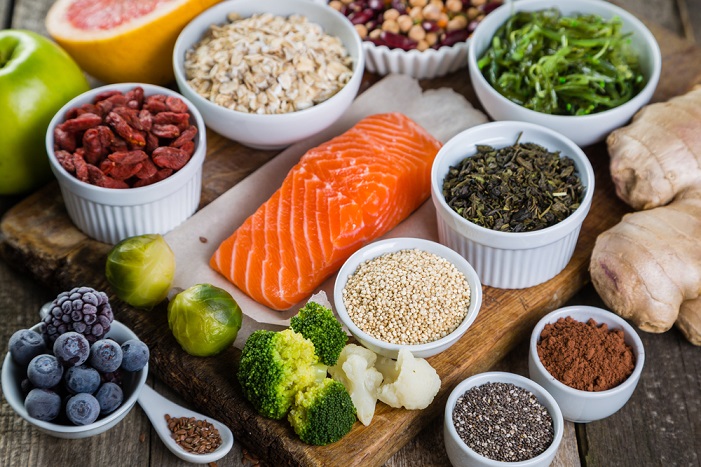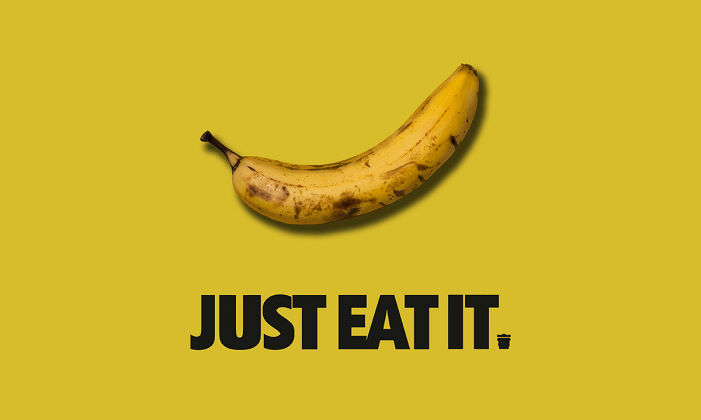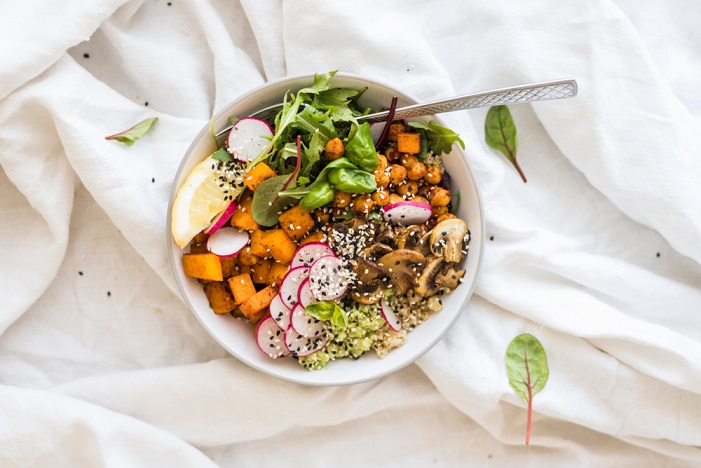The paleo diet – also known as the caveman diet, the hunter-gatherer diet, the Stone Age diet, or Paleolithic diet – is considered by many as a natural eating habit that helps you get in touch with your ancestral roots. But how do you shop for paleo in the modern world? We’ve got you covered with this paleo diet food list!
Did you know you can skip the whole shopping thing to make paleo even simpler? By getting chef-curated paleo meals delivered straight to your door every week, you can have ready-to-go meals in minutes without grocery shopping OR cooking! Looks like there ARE some perks to modern eating.
Download your complete paleo diet food list here
SUMMARY
The paleo diet keeps you rooted in nature with wholesome, unprocessed foods. Improve heart health, blood sugar, and reduce inflammation just by eliminating grains, dairy, and artificial ingredients!
Table of Contents
What is Paleo?
What You Can Eat on the Paleo Diet
Foods That Are Off Limits
Modified Paleo Diet
Example Paleo Diet Food List
Benefits of the Paleo Diet
Things to Consider Before Starting a Paleo Diet
What is Paleo?
In simple terms, the paleo diet involves eating foods that mirror what early humans ate during the Paleolithic era (nuts, seeds, meat, veggies, etc.) More specifically, it consists of only eating foods that were around before farming and modern processing techniques. This narrows down the diet to local, organic, non-GMO, whole produce and meats – anything a hunter-gatherer would have eaten.

By avoiding processed foods and eating more fruits and vegetables, paleo dieters can better reduce harmful inflammation, stabilize blood sugar, and improve heart health, energy levels, and more.
Paleo Diet Modifications
Many people modify their paleo diets to better fit their needs. In fact, the paleo diet is often considered a guideline for cleaner eating, rather than a strict regime to stick to.
Paleo diets can be updated as needed and can include things like some dairy, legumes, or whole grains to create a more well-rounded diet. Making these adjustments can also make a difference in your diet plan success because it can add a few “indulgent” foods to make mealtime more enjoyable.
As long as you make the healthiest choices with all your selections you can make a successful modified paleo diet plan: choose low-fat, whole grain, and organic as much as possible, and support your diet with lots of whole foods and cut back on highly processed foods with little-to-no nutritional value as much as possible.
SUMMARY
The paleo diet only allows for foods that could be naturally found before the advent of farming. However, many modify this diet to include dairy, legumes, and whole grains.
What You Can Eat on the Paleo Diet
A rule of thumb to follow is, if your ancestors could find it in the wild, you can eat it. That list would typically include:
- Grass-Fed Beef
- Wild Caught Fish & Seafood
- Fruits
- Vegetables
- Nuts
- Seeds
- Olive, Avocado, and Coconut oils
- Eggs
Grass-Fed Beef Vs. Grain Fed Beef
Research has shown that grass-fed meat is better for heart and brain health since it tends to be lower in fat and higher in omega-3 fatty acids. Grain-fed or “grain-finished” animals tend to reach their goal weights faster and will naturally have more fat. This means meat that is higher in calories.
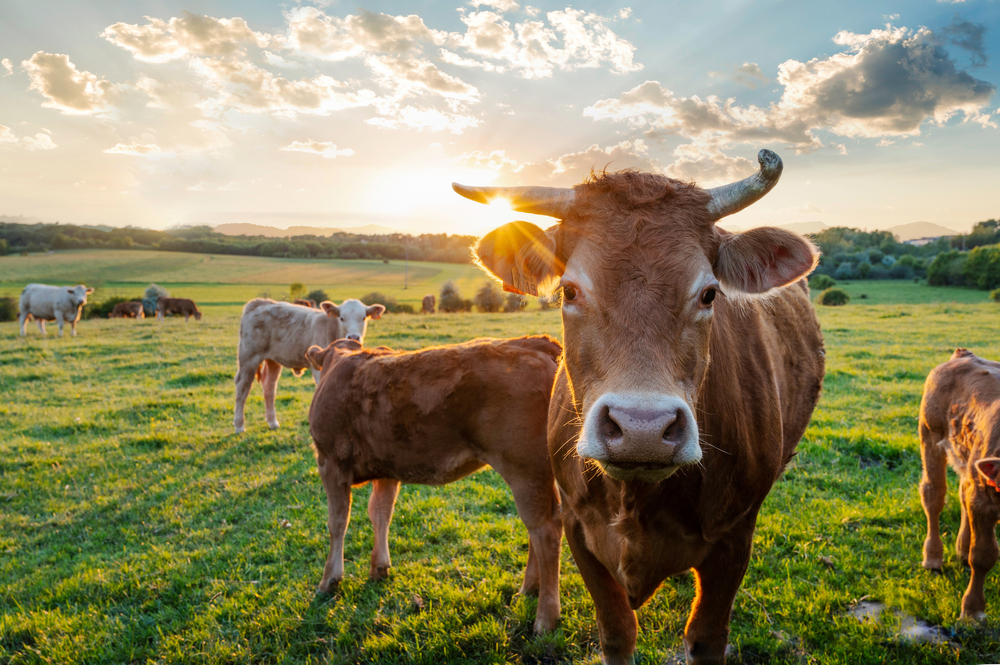
The quality of beef improves with grass-fed animals as well. Grass-fed beef will have a leaner fat content and less marbling, while grain-fed will have higher fat and more marbling, which affects flavor. Choose grass-fed beef if you’re looking to:
- Reduce your fat intake
- Improve heart health
- Get more antioxidants
While the type of meat you choose is a matter of preference, grass-fed is all-around a better choice if you are looking to follow a heart-healthier paleo plan.
Wild Caught Fish & Seafood Vs. Farm-Raised
Like beef, there are two different choices when it comes to your seafood and fish: wild caught and farm raised. Wild caught fish and seafood (as the name implies) come from their natural habitats, and farm-raised fish are raised in tanks. The pros and cons of each vary between nutritional value, cost, sustainability, and quality.
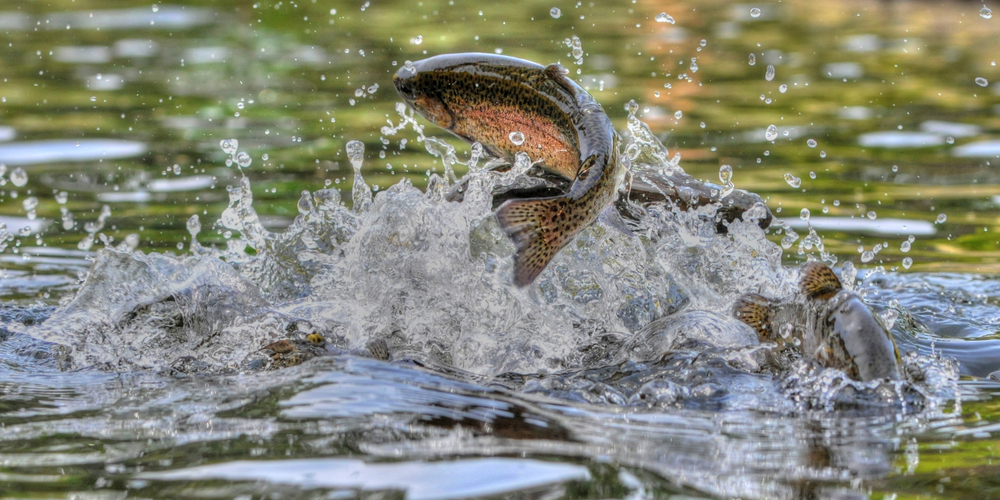
Wild caught fish are usually lower in saturated fat and have slightly higher levels of omega-3 fatty acids because of a more diverse diet. Farm-raised fish are more likely to have higher levels of contaminants or disease due to their captivity conditions. They are often fed antibiotics and have less nutritional value due to a less diverse diet. Most farm-raised fish, however, tend to be more sustainable and are cost friendly.
While the paleo diet emphasizes “natural” wild-caught fish, it is important to remember that times have changed since the Paleolithic era, and budget, environmental factors, and added hormones must be considered when selecting food. When choosing, weigh the benefits of each and decide which areas are most important to you.
(You can read more about the pros and cons of fish sources here and here.)
SUMMARY
Choose whole vegetables, fruits, nuts, seeds, eggs, and grass-fed meat as much as possible. Wild caught and farm raised seafood and fish have different benefits. Research which type is best for you!
Foods That Are Not Part Of The Paleo Diet
In general, the golden rule is to avoid anything processed. That means packaged snacks like cookies and chips, tofu, canned fish, cheeses, and baked goods. Basically, if any food has been preserved, canned, baked, dried, or altered in any way in order to prepare it, it’s considered processed.

Here are examples of processed foods to stay away from:
- Soda
- Syrups and Jams
- Fast Food & Fried Foods
- Muffins, Cupcakes, and Cookies
- Candy
- Chocolate
- Sauces, Dressings, Gravy
- Frozen Meals
- Sausages, Hot Dogs, and Deli Meats
- Cereals
- Canned Vegetables
- Ice Cream
Some people choose to follow a dedicated paleo diet and exclude even more items. A strict paleo plan does not allow:
- Beans, Peanuts, Peas, & Legumes
- All Refined Sugar
- Refined Vegetable Oils
- Salt
- All Grains (Including Whole Wheat, Barley, & Oats)
- Cheese & Milk
- Starchy Vegetables
This level of restriction is often discouraged by health experts because dairy, legumes, and whole grains are beneficial to your health. Eliminating them completely may cause you to miss out on important minerals, fiber, and vitamins. For this reason, an adapted or modified paleo diet may be healthier and more ideal for the long-term.
SUMMARY
Paleo restricts processed, artificially sweetened foods like baked goods, fast food, cereals, ice cream, soda, and candy. Some people choose to also completely eliminate beans, legumes, lentils, whole grains, dairy, and starchy vegetables from their diets as well, though this is often discouraged by experts.
Modified Paleo Diet
Adjust your diet to better fit your needs! Because paleo can restrict foods that give your body important nutrients, it’s important to make it work for you.
Paleo might also take away some of the foods you already love, which can make it hard to stick to your diet. A relaxed plan will still give you the benefits of paleo while still letting you indulge in a broader selection of foods.
Love cheese? Allow yourself a serving of low-fat mozzarella or feta every now and then! Is bacon a staple in your morning routine? Have a couple slices of turkey bacon with the fat trimmed off! Craving dessert? Have a piece of dark chocolate! Finding the healthiest option for these foods is key!

Modified paleo plans allow you to still enjoy:
- Low-Fat Milk
- Low-Fat Yogurt
- High Sugar Fruits
- Starchy Vegetables
- Quinoa & Brown/Wild Rice
- Whole Wheat Bread
- Butter
- Turkey Bacon & Sausage
- Dark Chocolate
- Wine & Beer
- Sweeteners like Stevia & Spirulina
SUMMARY
Modifying your paleo diet can help you stick with your diet in general and help you get all of the nutrients you need.
Limiting Dairy and Carbs on Your Paleo Diet Food List
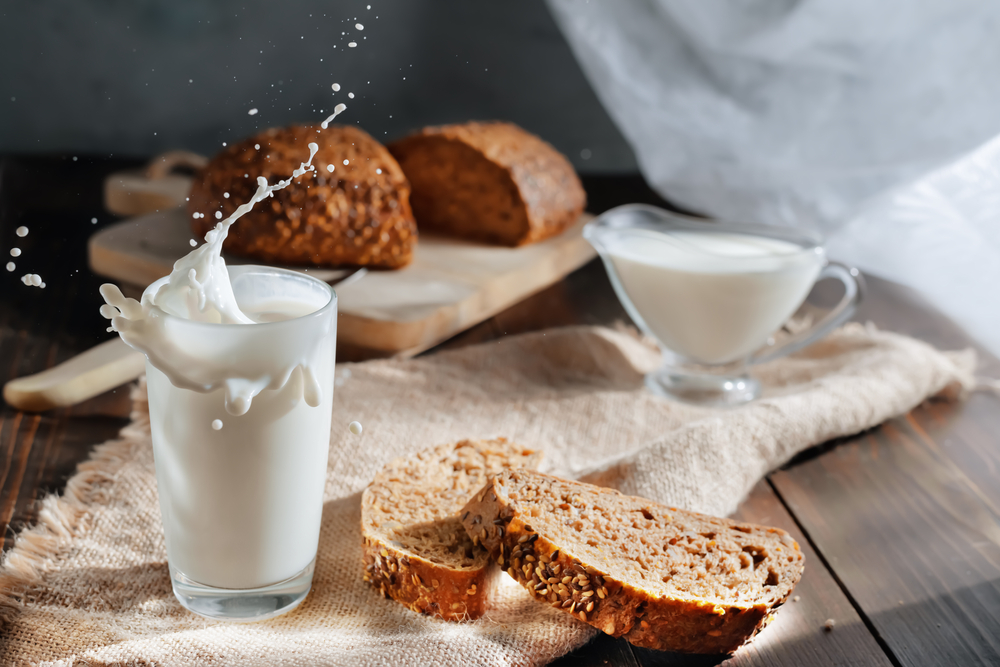
You may think limiting your intake of carbs and dairy is good for you, but the truth is our body needs carbohydrates for energy and calcium and other micronutrients from dairy to stay healthy.
While it’s true some diets (like the keto diet) encourage you to limit carbs and force your body to burn fat for energy instead, this is not ideal in the long run. The truth is, complex carbs and low-fat dairy have lots of benefits like fiber, protein, calcium, Vitamin D, and more. If you cut them from your diet completely you will be missing out on lots of health benefits!
Example Paleo Diet Food List
This list does not follow a strict paleo regime, but it is still considered highly paleo appropriate. If you want to be stricter with your diet, skip shopping for any grains or dairy products (bolded products) included on this paleo diet food list.
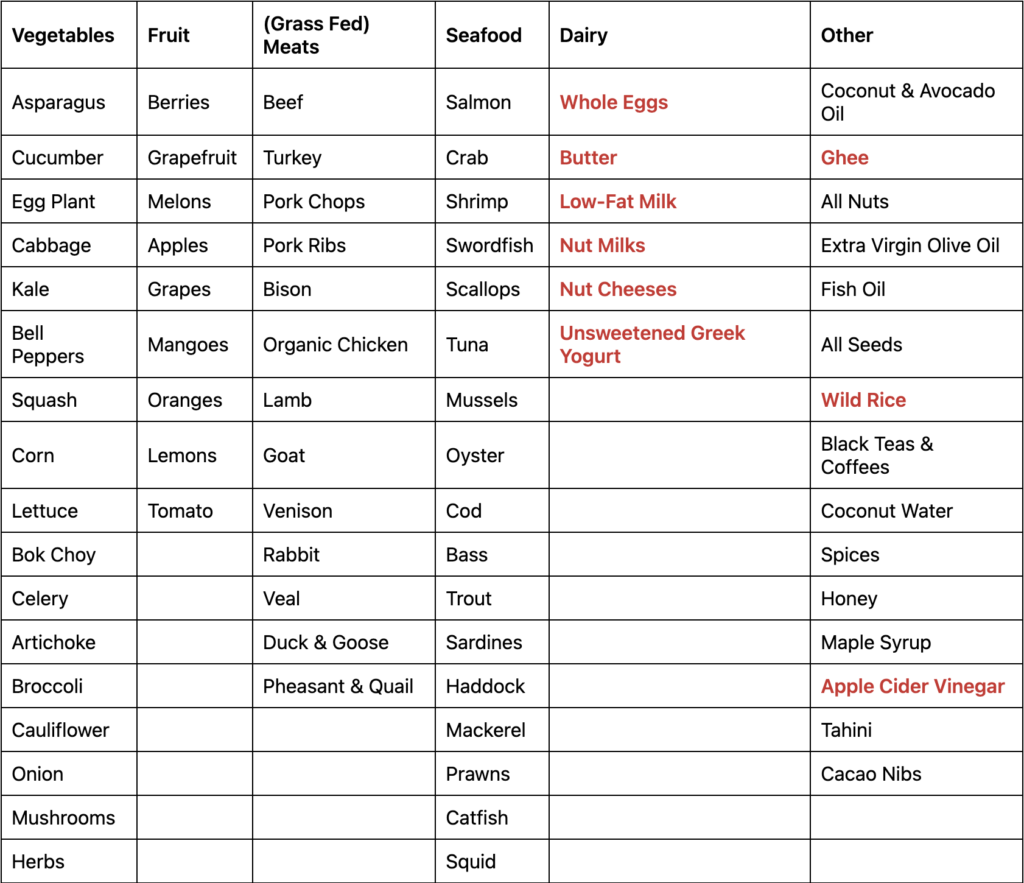
Shopping Tips
Not all products labelled paleo-friendly will align with your diet goals! Some may include foods you have chosen to avoid, and others may have hidden sugars or grains, altering their calories and carb content.
Keep an eye out for organic, grass-fed, and no added sugar labels while shopping to find the best paleo diet foods, but always check the nutrition label to make sure there are no surprise ingredients! Just because a package says “no added sugar” or “low salt” does not mean they are sugar or sodium free.
Also be sure a food’s nutritional content is beneficial too! Snacks with empty calories won’t do you any favors. Try choosing items that have a variety of nutrients, vitamins, and fiber.
SUMMARY
Check nutritional label as much as possible when shopping to make sure your groceries are actually paleo-friendly.
Benefits of the Paleo Diet
Paleo is beneficial for a few reasons: it adds more fruits and vegetables to your diet, it encourages you to seek out healthier food options, it removes processed foods high in trans fats, and lowers the amount of carbohydrates you eat. Because of this, paleo may help with several health issues:
- Promotes weight loss
- Stabilizes blood sugar, and boosts insulin sensitivity
- Reduces blood pressure
- Lowers triglycerides
- Helps with diabetes
- Improves heart health
- Improves cholesterol
Things to Consider Before Starting a Paleo Diet
Paleo might be considered too strict for modern-day shoppers. Having to search for non-GMO, non-processed, no sugar, grain-free items is not always ideal when you’re on a budget. It’s also not always ideal when you’re in a hurry and don’t have time to cook a full meal. Like most diets, paleo works best if you have access to healthy foods and are smart about meal prepping.

It’s also important to consider your personal nutrition goals. Strict paleo diet food lists may not work for you if you’re missing out on beneficial ingredients like whole grains and legumes. Try adding foods that are restricted from a strict paleo diet to be more well-balanced.
Working with a dietician is never a bad idea if you don’t know where to start! And if you need extra help figuring out how to make delicious paleo approved meals, the Fresh N Lean kitchen can always take care of that for you.


